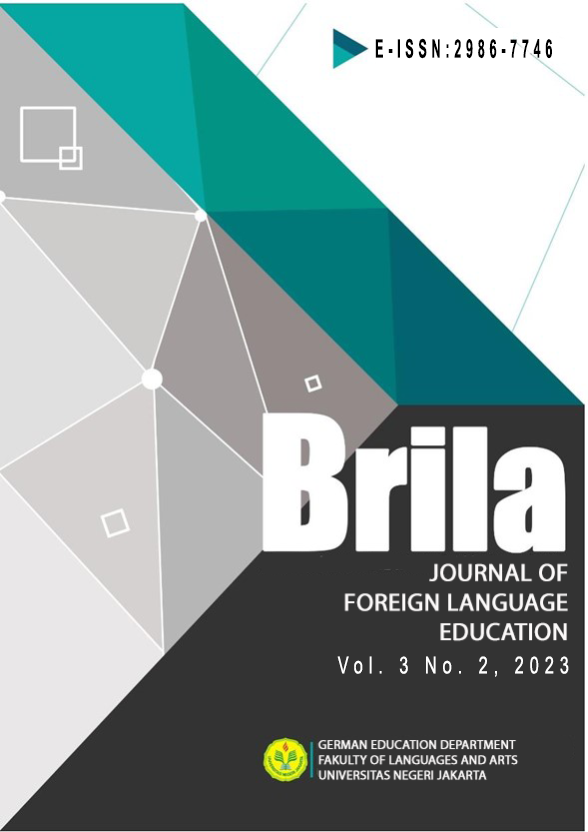Unjuk Kerja Teknik Higi-wydler pada Penerjemahan Idiom dalam Novel Herr der Diebe Karya Cornelia Funke
Keywords:
idiom, Herr der Diebe, novel, terjemahan, teknik Higi-WydlerAbstract
The objective of this research is twofold: (1) To provide a description of the use of the Higi-wydler idiom translation technique in the translation of the German novel "Herr der Diebe" (2000); (2) To categorize and analyze the outcomes of the idiom translation using the Higi-wydler's technique. This research aims to influence the decision-making process in selecting sub-techniques of Higi-wydler's as a general guideline or rule of thumb, particularly for translators. This study used a descriptive analytic approach to compare the original and translated versions of a book named "Pangeran Pencuri/The thief lord" (2006) in both German and Indonesian languages. Data collection in this study involved the utilization of note-taking strategy. To validate the data, the Idiom Dictionary Duden Redewendungen (DR) (2013) and Kamus Idiom Bahasa Indonesia (KIBI) Abdul Chaer (1984) were employed. The results of this investigation are as follows: (1) The Higi-wydler idiom translation approach was most commonly used for the null Äquivalenz category, namely for 45 idioms, which accounts for about 97% of the total; (2) Only 3% or 1 idiom, fell under the total Äquivalenz category; (3) None of the 46 detected idioms could be classified as partielle Äquivalenz. This demonstrates the considerable challenge in finding suitable counterparts for translating such idioms. Therefore, it is necessary to rephrase the translation of idioms owing to the distinct differences in both the structure of Bahasa Indonesia and its culture compared to the German language and its culture. Doing so would present a formidable challenge for the interpreter.
References
Borgin, S. (2019). Makna leksikon Katze dalam Peribahasa dan Ungkapan Bahasa Jerman: Analisis Linguakulturologi. Jurnal Sora: Pernik Studi Bahasa Asing, 4(1), 8-18.
Burger, H. (2007). Phraseologie: ein internationales Handbuch zeitgenössischer Forschung (Vol. 28). Walter de Gruyter.
Catford, J. C. (1968). A Linguistic Theory of Translation. Foundations of Language, 4(4), 451-452.
Chaer, A. (1984). Kamus idiom bahasa Indonesia.
Djajaprawira, H. (2011). Perubahan Peran Seni Pada Masyarakat Bali. Jurnal Bahasa & Pariwisata.
Funke, C. (2000). Herr der Diebe. Dressler Verlag.
Hendarto, S. (2006). Pangeran pencuri. Gramedia Pustaka Utama.
Heuken, P., & Sinaga, E. R. T. (2013). Deutsch-Indonesisches Wörterbuch= Kamus Jerman-Indonesia.
Higi-wydler, M. (1989). Zur Übersetzung von Idiomen: eine Beschreibung und Klassifizierung deutscher Idiome und ihrer französischen Übersetzungen. P. Lang.
Hoang, V. (2006). Translation: Theory and practice–A textbook for senior students of English. Nhà xuất bản Giáo dục.
Karsam, D., & Agustina, T. (2018). Analisis Buku Ajar (Lehrwerkanalyse) Bahasa Jerman Studio D dan Netzwerk dalam Pengajaran Bahasa Jerman di Stba Yapari-Aba Bandung. Jurnal Sora: Pernik Studi Bahasa Asing, 3(2), 102-116.
Kashgary, A. D. (2011). The paradox of translating the untranslatable: Equivalence vs. non-equivalence in translating from Arabic into English. Journal of King Saud University - Languages and Translation, 23(1), 47-57. https://doi.org/https://doi.org/10.1016/j.jksult.2010.03.001
Martawijaya, A. P., & Hidayat, Y. (2018). Analisis Penerjemahan Frase: Studi Kasus pada Penerjemahan Frase Bahasa Jepang ke Bahasa Indonesia oleh Mahasiswa STBA YAPARI-ABA Bandung. Jurnal Sora: Pernik Studi Bahasa Asing, 3(2), 62-74.
Martawijaya, A. P., & Lestari, A. (2022). Teknik Penerjemahan Kanjou Hyougen pada Komik “Yakusoku No Neverland”(Shirai, 2016). Jurnal Soshum Insentif, 5(2), 147-158.
Nord, C., & Kömer-Beneš, V. (1988). Textanalyse und Übersetzen. Theoretische Grundlagen, Methode und didaktische Anwendung einer übersetzungsrelevanten Textanalyse. Heidelberg: Groos, 1988.-ISBN 3-87276-598-1. 314 Seiten, DM 29. Informationen Deutsch als Fremdsprache, 15(5-6), 641-643.
Pratama, D. A. (2016). Prosedur Terjemahan dalam Terjemahan Komik Prancis Spirou Et Fantasio À New York Karya Tome & Janry. Jurnal Sora: Pernik Studi Bahasa Asing, 1(1), 1-7.
Rachmawati, T. (2016). Teknik penerjemahan idiom bahasa Jerman dalam roman reckless : steinernes fleisch karya Cornelia Funke dan Lionel Wigram ke dalam roman terjemahannya Reckless. Prodi Pendidikan Bahasa Jerman FBS UNJ.
Sudaryat, Y. (2009). Meaning in Discourse of Semantic and Pragmatic Principles. Bandung: Yrama.
Sutami, H. (2014). Kamus Besar Bahasa Indonesia Pusat Bahasa; Edisi Keempat. Wacana, Journal of the Humanities of Indonesia, 11(2).
Syawalina, L. (2016). Analisis Kesalahan Mahasiswa Semester VIII dalam Konsep Terjemahan Indonesia-Perancis di Jurusan Bahasa Perancis STBA YAPARI-ABA Bandung. Jurnal Barista, 3(1), 98-111.
Toljamo, A.-M. (2017). Veränderungen in der Beschreibung der drei zentralen Merkmale des Phrasems von 1973 bis 2015. Dargestellt an Idiomatik des Deutschen und Phraseologie. Eine Einführung am Beispiel des Deutschen von Harald Burger.
Uryadi, U., & Bungara, M. (2021). Terjemahan Idiom Bahasa Jerman dalam Novel Anak Drachenleiter. 1, 18-33.
Wisudawanto, R., & Huntley, M. L. (2022). The Role of Degree of Relevance in Assessing Translation of Satire. Jurnalistrendi: Jurnal Linguistik, Sastra, dan Pendidikan, 7(1), 119-127.
Worsch, W., & Scholze-Stubenrecht, W. (2013).





